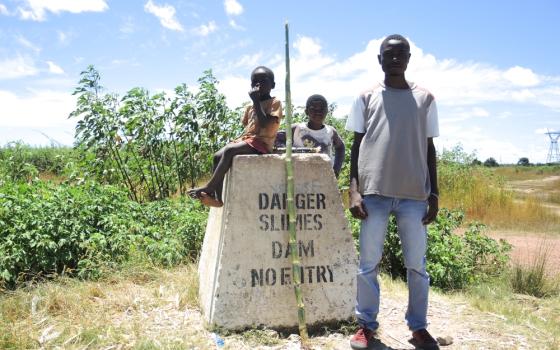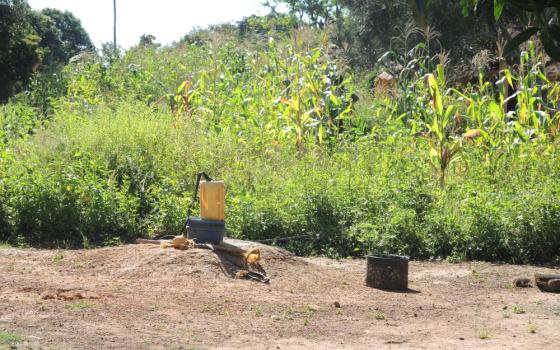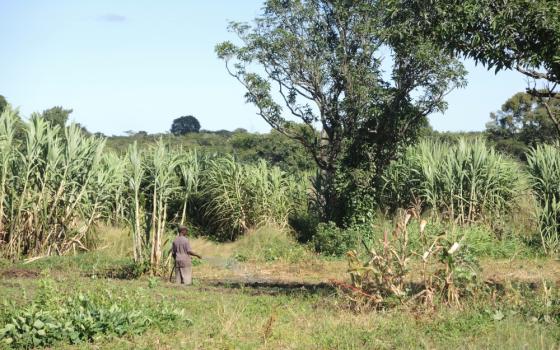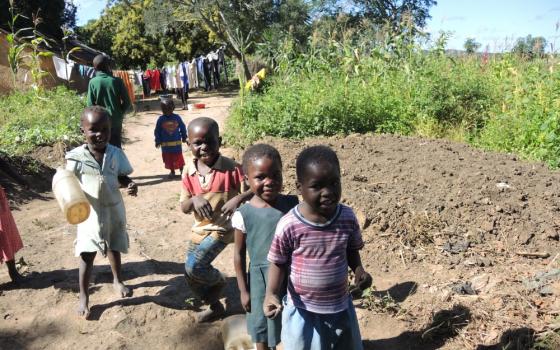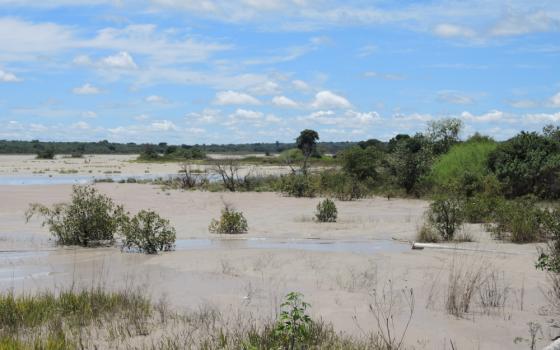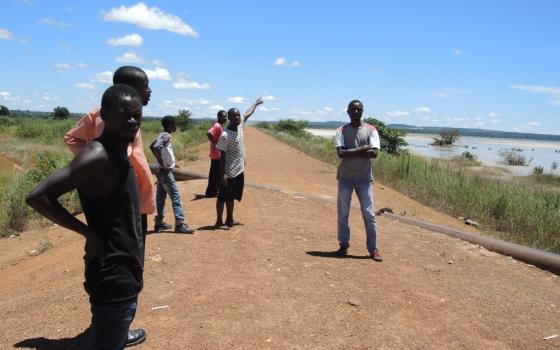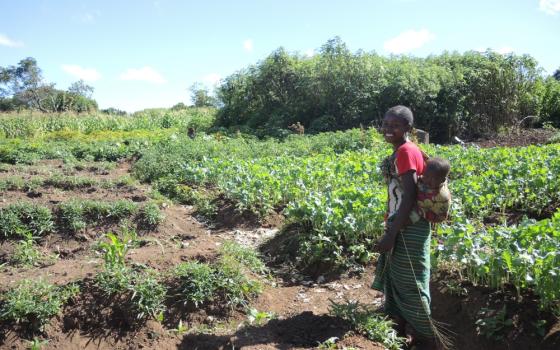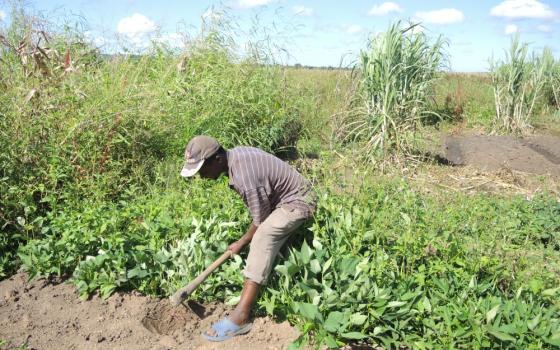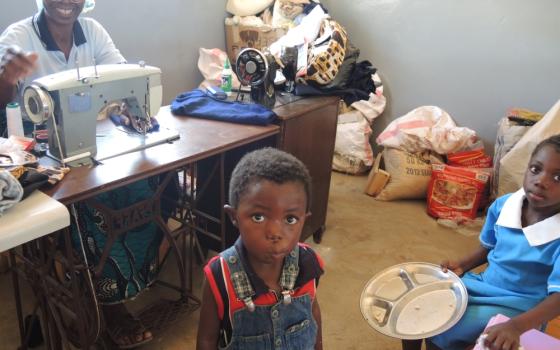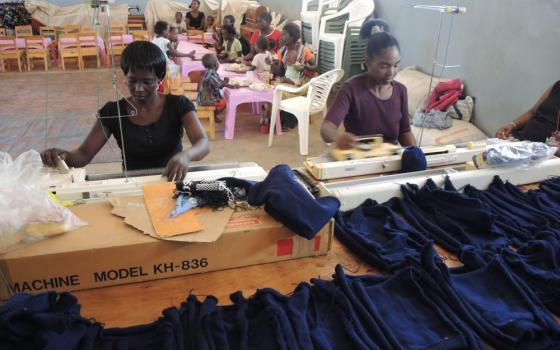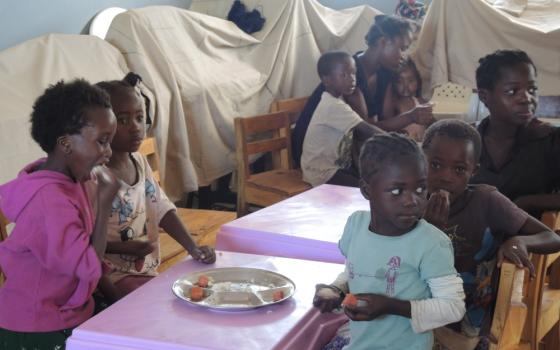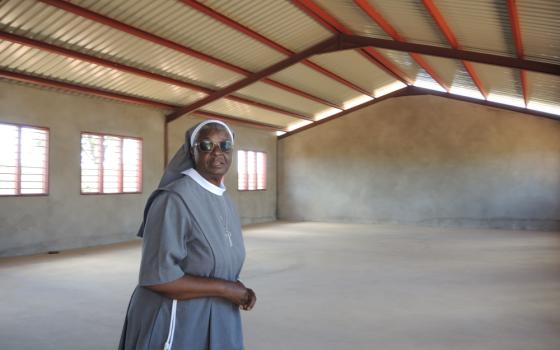The village of Kawama lies nestled on the shores of a peaceful lake. Just 6 kilometers (3.5 miles) from the absolute chaos of the border crossing with Congo, Kawama is a quiet farming hamlet. There’s a breeze coming off the lake. The paved road is 5 kilometers away and there’s no electricity, so the silence is broken only by roosters crowing and children playing.
Extensive mining operations across northwestern Zambia have depleted groundwater, making farming difficult for most Zambians, but farmers in Kawama enjoy plenty of water from their lake. While farmers just a few villages away grow tiny, stunted corn and scraggly tomato plants, the farmers in Kawama have sugar canes stretching proudly towards the sky and cabbages growing in neat rows on the ground.
Other Zambians need to walk kilometers just to get to a communal water source, but every mud and wood shack in Kawama has a well dug right next to it.
The lake next to the village of Kawama is not a natural lake, though. It’s the result of the Lubengele Tailings Dam, built by Konkola Copper Mines to contain water contaminated by sulfuric acid and other chemicals used in the extraction of copper. Though the presence of water allows vegetables to thrive, there is concern that chemicals in the water could leech into these crops and the drinking water. Studies in other areas by Caritas, the international Catholic relief and development organization, have shown a variety of medical problems that stemmed from living near mines, including diarrhea, abdominal problems and a high mortality rate for children under 5.
As Pope Francis issues his encyclical on the environment this month to explore the theological responsibility of protecting the planet, women religious across the world have been working in areas of environmental emergencies, like climate change in Vietnam, uranium mining in New Mexico and a proposed mine in Guatemala. In northwestern Zambia’s Copperbelt, four Franciscan sisters are struggling to care for an impoverished population in the area of Chililabombwe, which has been environmentally desecrated by copper mining.
The production of copper is inextricably linked to Zambia’s history, from colonial times to independence in 1964, through the country’s economic boom in the 1970s and ’80s as the price of copper soared, to the crushing poverty today when Zambia is one of the least developed countries in the world. According to research from Caritas and the Catholic diocese of Solwezi, mines actually create pockets of poverty around them, due to the economic practices of the mines and the environmental devastation that ruins farmland.
Copper mining, like many environmental issues, is so complex and enormous that any significant change will require cooperation on all levels – community, religious, governmental and commercial, among others. When companies take advantage of the ignorance and illiteracy of local people, harmful practices can continue.
But the first step, argue activists in Zambia, is documenting and studying the problems so the communities know exactly what kind of environmental risks they may be facing and how to adequately protect themselves.
Caritas Zambia and the Catholic diocese of Solwezi are at the forefront of this movement to document these environmental issues. They are working with other Christian organizations in Zambia such as the Evangelical Fellowship of Zambia and the Council of Churches Zambia on the issue of mining, but Caritas and Solwezi diocese concentrate on study and documentation.
“Once the communities have the information and they have the knowledge, it is easier for these communities to know how to protect themselves,” said John Kalusa, the diocesan coordinator working for both the Catholic diocese of Solwezi and Caritas.
One of the Caritas publications is a 60-page book detailing the locations of mines in Zambia and what minerals they produce. Up until Caritas started publishing the book, there was no public information available about even something as simple as the locations of all the mines in the country.
The government issues permits for the mines, so it knows the locations, Kalusa said. But the government “has what I may call a ‘policy’ that some information is confidential. They don't want a lot of people to be aware.”
Back in Kawama, a lack of information could be endangering the 1,538 residents of the village.
“The mines came and tested the water and said, if we put chlorine in it, it’s safe to drink,” said Teresa, a resident of Kawama. But chlorine may not be sufficient.
“Unless you know the concentration of the acid [in the water], all those could be good theories,” said Kalusa. “The mine would not want to risk its business and reveal all the percentages.”
“When innocent people look at the health of the very nice vegetables, it’s very tempting. So they use them, but you don’t know what you are doing to your body, which chemicals you are inviting into your body,” he said.
Caritas and the Solwezi diocese are currently working on a large study of Kawama, to try to determine what the residents may need to do to protect themselves. But they’ve struggled to get cooperation from the leadership of Konkola Copper Mines, because Caritas and the diocese want to ensure that the company has time to review and comment on their study. They also don’t want to alienate the company, since it would be an important partner in implementing changes.
The spokesperson for Konkola Copper Mines based in Chingola, Shapi Shachinda, refused to comment for this article. Multiple attempts by Global Sisters Report to contact other offices, including Konkola’s parent company Vedanta, which is based in England and India, were also unsuccessful.
Where do pennies come from?
Zambia produced approximately 830 tons of copper in 2013, according to the U.S. Geological Survey, which documents worldwide mineral production. The biggest copper producer is Chile, with 5,700 tons.
Konkola is one of the largest companies in Zambia, responsible for mining a quarter of Zambia’s yearly copper production.
Copper is produced by digging deep into the earth in copper-rich areas, such as Zambia’s Copperbelt region, where deposits of copper average 2.3 percent.
Workers remove the ore, the raw material of rock mixed with the copper minerals, using blasting techniques. Other workers grind the ore into smaller pieces. Chemicals such as sulfuric acid are used to separate copper from the rock waste. The extracted copper is smelted, or treated at high temperatures, in another location and manufactured into large sheets that are exported around the world.
Copper, which resists corrosion and conducts heat and electricity efficiently, is in high demand because of these properties and because it is used in building construction, electronic and mechanical product manufacturing and power generation – practically everywhere.
In Zambia, there are two types of copper mines: open-pit mines and underground mines. Open-pit mines are enormous gashes in the surface of the earth, kilometers deep. Residents near open-pit mines suffer from a lot of respiratory and eye problems due to a continuous acid mist that rises from the pits, according to Caritas studies in Zambia. With underground mines, residents can often feel the workers blasting tunnels under their homes, though the amount of vibrations is supposed to be governed by Zambia Environmental Management Agency guidelines.
The Konkola mine, the underground mine near the town of Chililabombwe, is one of the wettest mines in the world. According to the company, which takes its name from the mine, there are approximately 400,000 cubic meters of water that flow into the mine every day, enough to fill 160 Olympic-size swimming pools.
All of this water needs to go somewhere, so the company pumps it out with a series of pumps through a cleaning process before returning the cleaned water to the Kafue River, a major waterway in Zambia.
Plugging a finger in the dike
The tailings dam holds the excess water, called effluent, some of which is pumped out of the mines and some of which is used during the refining process. The effluent contains things called “suspended solids,” which can be any foreign material from acids or very fine particles of rock. The effluent from the Lubengele Tailings Dam undergoes a cleaning process too, part of which is that these suspended solids, like the rock particles, naturally settle to the bottom, allowing cleaner water to pass on top, where it returns to the Kafue River. The Zambia Environmental Management Agency monitors the water in the Kafue River at a variety of different points to ensure that the water does not exceed certain levels of pollutants.
The company’s website says that they have invested $20 million to reduce the amount of suspended solids in the water pumped out of the mines, as part of an overall infrastructure investment of almost $3 billion. One byproduct of the modernization is that it has improved the company’s emissions and pollution. Many of the environmental problems in the mines also date back decades, when environmental laws were more lax.
“A tailings dam is a place [the company] selects where all the used acid and chemicals are deposited,” said Kalusa, the coordinator with Caritas and the Catholic diocese of Solwezi. “[The land under the dam] is destroyed permanently forever and ever. No crops shall grow on such a ground, no life shall exist on such a ground. That is a tailings dam.” The danger also extends to the life that exists around the perimeter of the dam, like Kawama, though vegetation and crops do grow there.
There are approximately 3,500 tailings dams worldwide around mining projects. One of the biggest dangers concerning water that is pumped out of mines around the world is the possibility of leaks.
The Konkola Copper Mines company is still dealing with the aftermath of a leak of contaminated water in a nearby mine in Chingola in November 2006.
Chingola is located 25 kilometers south of Chililabombwe, built around the Nchanga Open Pit Mine. According to court documents, in early November 2006, people started going in droves to the local medical clinic, complaining of stomach pains, diarrhea, vomiting, chest pains and sight problems, among other things. Residents noticed a massive die-out of fish in the Kafue River. Stones and vegetation along the Kafue River changed color; the water had a blue-green tinge around the edges. There was a foul smell, and water used for drinking had bubbles in it long after boiling. Plaintiffs told the courts in 2010 that when they requested their medical reports from the Konkola Copper Mines clinic, the clinic told them that medical reports were company property and refused to release them.
Joseph Sakala, manager inspectorate at the time for the Environmental Council of Zambia (the pre-cursor to ZEMA), testified that the water runoff from the mines had a pH level of 2.8, which is very acidic. Regular water generally has a pH of 6-8.5. Further testimony during the case established that the leak came through corroded pipes and infrastructure, which was supposed to carry the water to treatment but instead allowed it to enter the Kafue River. Sometimes pipes corrode when a company does not add enough lime, a basic substance that offsets the acidity, to the outflow, experts testified.
"There was gross recklessness, whether human beings died or not,” Justice Phillip Musunda wrote in his ruling on Dec. 31, 2010. “They deprived the community in Chingola the right to life, which is a fundamental right in our constitution. They disregarded environmental legislation at a time, when there is concerted international effort especially by the United Nations Environmental Program (UNEP) to protect the environment. Such disregard for human life was received by this court with a sense of outrage.
"The first defendant [Konkola Copper Mines] must [bear] moral, criminal and civil liability for this appalling tragedy. Here is a Multinational Enterprise, which has no regard for human life for the sake of profit and turned the residents of Chingola into ‘Guinea Pigs’ and showed no remorse. In their countries of origin such recklessness would have been visited by severe criminal and civil sanctions."
(Konkola Copper Mines is a subsidiary of Vedanta Resources, which is listed on the London Stock Exchange.)
The judge ordered Konkola to pay 4 million Kwacha (about $800) to each of the 2,000 plaintiffs, along with a number of other fines, for a total penalty of almost $2 million.
Eight years later, the 2,000 plaintiffs from the case are still waiting for their compensation, as Konkola appealed the ruling. On April 2, the Zambian Supreme Court upheld the 2010 ruling, which found the company guilty of water poisoning. According to the London-based watchdog group Foil Vedanta, 20 plaintiffs have died of liver and kidney failure and other diseases likely caused by the leak while awaiting compensation.
The lesson is sobering: Even when the residents overcome crushing poverty and ignorance of their legal rights to organize and demand compensation, even when they presented an unassailable case, even when the courts heard their case and ruled in their favor, the residents have not received compensation.
A wall of silence
The major problem for the residents of Kawama is they don’t have a way to protect themselves before a leak might occur. Due to the Chingola court case, there are documented instances of what happens after a leak. But few want to talk about the potential daily risks of living next to the tailings dam, or the possibility of corroded pipes slowly leaking polluted water into the Kafue.
The residents’ options, explained Kalusa, are bleak. The best-case scenario is to simply leave the area, an impossibility for farmers who don’t have the capital to move, especially since no one will buy their homes.
“Those who can afford to import water, or buy water in bulk, should do so for drinking and cooking,” he said. “They can use water from the wells for things like washing clothes or bathing, but they need to have access to clean and safe drinking water.”
Even when I visited in March, accompanied by one of the Franciscan sisters who knew a priest active in the area, residents were suspicious of strangers. Few people agreed to be photographed, and no one wanted to give their last name. The sisters asked me not to take out my notebook while walking around.
Living next to the dam poses a lot of risks, but the mines are the only economic engine in the area, the only ticket out of poverty. Anyone I asked about problems with skin, eye or lung problems told me they had no medical issues. “I’ve never had an experience of that kind,” said one mother, who refused to be photographed or give her name. “Before, we used to have health problems because of a pig disease. But we got rid of the pigs and now we don’t have problems anymore.”
Kalusa dismisses the pig disease theory. The reticence to discuss problems comes from a deeper fear, he explained. The mines in this area are everything. They are practically the only paycheck available. They may be the cause of a host of environmental problems, but the promise of a job sustains them and even draws people to the area from different parts of Zambia.
Sr. Josephine Mulenga, the superior of the Franciscan sisters in Chililabombwe, attempted to explain the mines’ importance. “You can find any young person, and when you ask what he wants to be when he grows up, he will always answer that he wants to be a miner,” she said.
The sisters are themselves in the midst of a building push, trying to increase their services in the area. Their flagship program is called Mt. Purpose Mother Angela Skills Center, which has a feeding program that provides local children with 2,000 meals per week. This is after the cutbacks, when financial difficulties forced the sisters to stop providing meals for teenagers and focus on children only.
The skills center is currently under construction pending fundraising, but it will eventually help local men and women to learn skills like carpentry, woodworking and sewing. This will also provide an economic alternative to working in the mines. The sisters are building a non-residential school for 150 orphans, too.
Community-based change
The only way to effect meaningful change in the area is to help the residents recognize and advocate for themselves, explained Kalusa. Caritas and the Solwezi diocese are in the process of organizing “CACs” or community advocacy committees of about 10 to 15 members.
“These are people who live in the same communities, who have the same opportunities and challenges,” he said. “We train them on how to first of all identify a problem that affects them all. After they identify a community challenge, they are given methodology to begin advocating for themselves.”
Much of the community advocacy committee work centers on getting residents to ask important questions. If the tailings dam has polluted the groundwater, who should they turn to in order to demand free, safe drinking water? “They have to know who to target. The investor? The government? The policymaker? The traditional leader, the chief? Or do they have to target several people?”
Across northwestern Zambia, some community advocacy groups have appealed to mining companies after underground blasting caused cracks in their homes.
Kalusa said a major challenge is helping the CACs understand the importance of protecting the environment because it is their livelihood.
“For example, with charcoal, that’s the leading cause of deforestation,” he said. “But when you reach a place people tell me, ‘If I stop burning charcoal, are you going to feed me? This is where I get income.’ So you have to say, ‘OK, now you’re getting income from this, but in 10 years there won’t be any trees to cut.’”
Grassroots work is always a slow process. And as the Chingola court case illustrates, even when organizing 2,000 people is successful, it doesn’t mean that the residents will be compensated. In the meantime, farmers will continue growing their crops using water from the Lubengele Tailings Dam. Children will continue splashing each other when they take a bath, and mothers will continue cooking with the same water from their wells.
Perhaps the levels are safe for human consumption for the time being, but without a study documenting the levels, everyone is living in a type of limbo created by a knowledge vacuum.
“We believe that information and knowledge is very cardinal,” said Kalusa. “When you know the dangers, you can know how to avoid them. So our biggest role is to make the communities have the facts at their fingertips. Not rumors, but the facts. They must know. And once they know, it's up to them.”
[Melanie Lidman is Middle East and Africa correspondent for Global Sisters Report based in Israel.]
